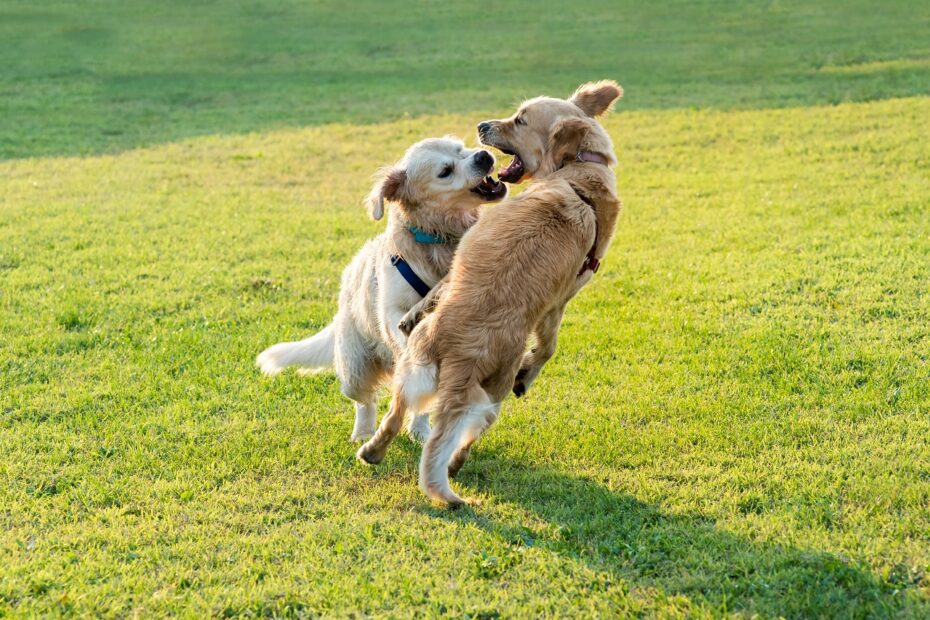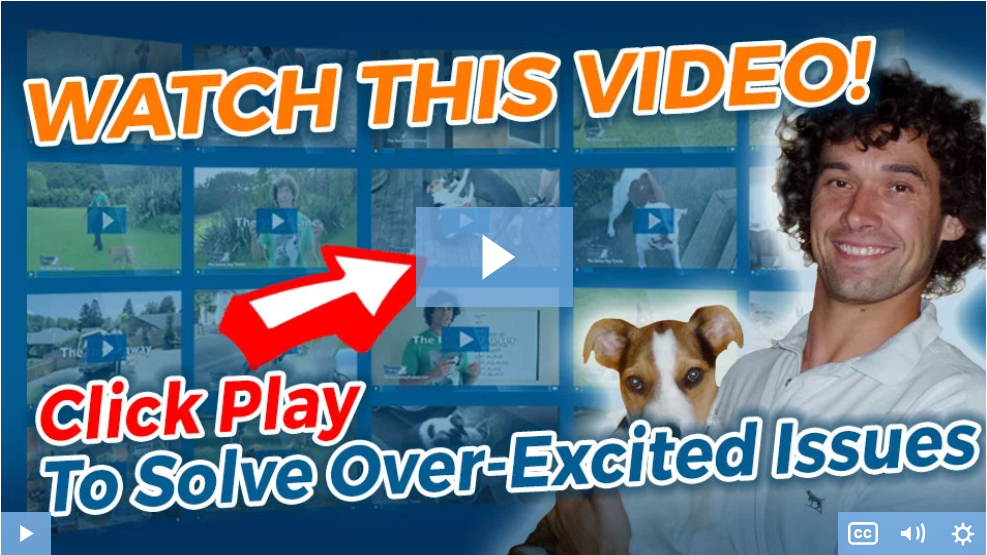My dog goes crazy around other dogs… it’s a sentence many dog owners are all too familiar with.
You know how it is… you’re walking happily down the sidewalk with your pooch.
They’re relaxed and peaceful, and so are you. And then suddenly, another dog comes into view.
Instantly, your quiet, calm dog transforms into a crazy wild child. They’re lunging, barking, jumping. And they’re pulling so hard on the leash, you think your arm might break.
It’s embarrassing, right? Not only that, it can be dangerous. A dog that invades another dog’s personal space isn’t always viewed kindly.
If the other dog reacts badly to your own dog’s behavior, things can quickly escalate.
Worse still, the problem isn’t always restricted to walks. Some dogs will display the same craziness whenever and wherever they come across another dog. Whether that’s in your home, at a day center, or in the yard.
Many owners interpret their dog’s behavior as aggression. Often, it doesn’t start off that way.
Most ‘crazy’ behavior has its roots in overexcitement or hyperactivity. The problem is, those two emotions can all too easily lead to aggressive behavior, especially if there’s an element of fear or anxiety involved.
Some of the methods we use to control the situation can just make it worse.
Pulling on your dog’s collar or leash if they’re trying to get to another dog can just aggravate the behavior.
Similarly, shouting and yelling will just heap negative energy onto negative energy. Punishing the behavior simply feeds into your dog’s negative associations with other dogs, leading to further problems down the line.
So, what’s the solution? How can you turn the situation around?
Fortunately, very few problems are insurmountable. And with a bit of effort on your part and a bit of willingness on your dog. Those undesirable behaviors could soon become a thing of the past.
The first step? Helping your dog to master their emotions.
Doggy Dan’s Dog Calming Code is an invaluable tool in teaching your dog control. (see video below)
Once you start implementing the techniques Dan demonstrates into your routine, you’ll notice a dramatic difference in your dog’s behavior, not to mention their aptitude for training.
Here’s the link to take a look: Click Here To Check Out The Dog Calming Code And Discover How To Finally Stop Your Dogs Crazy, Overexcited & Naughty Behavior… Even If You’ve Tried & Failed Before!
(video will open in a new window)
Why Do Dogs Go Crazy?
Before you jump straight in with a fix, take a moment to consider what’s motivating your dog’s behavior.
If you can understand the reason behind the craziness, you’ll be better primed to address it with the appropriate solution.
Some of the most common causes include…..
Frustration
Some dogs just want to play. They want to walk straight up to another dog, say hello, have a sniff, and then get down to some friendly tussling.
The problem is, we don’t let them. Or at least, that leash around their neck doesn’t.
When dogs are routinely denied the opportunity to get what they want, they become frustrated. And when they become frustrated, they’re rarely inclined to keep it to themselves.
Anxiety
When some dogs get anxious, they’ll try to retreat as quickly as possible from the source of their anxiety.
Others go the opposite way.
Rather than back away, they’ll actively try to check out the source of their fears.
If your dog snaps, lunges, and acts in otherwise out-of-character ways during a normal meet and greet, they might very well be feeling way outside their comfort zone.
Inter-Dog Aggression
A dog doesn’t have to be inherently aggressive to display aggressive types of behavior. Even normally calm, well-behaved dogs can display undesirable behaviors in triggering situations.
Some dogs will become aggressive if they feel their pack, their home, or even their possessions are under threat.
Dogs with fearful tendencies may become aggressive in self-defense.
Others will display aggression as a means to dominate.
Unneturted males may become aggressive as a way of competing for female attention.
Sometimes, the problem can be exaggerated by learning or genetic factors.
It’s not always easy, but pinpointing the cause of the aggression in your own dog’s case is key to modifying it.

Excitement
Sometimes, a dog’s emotions can run away with them. If their excitement at seeing another dog reaches boiling point. They’ll do anything they can to get near them, including acting in ways you’d really rather they didn’t.
Although excitement isn’t born from aggression, it can sometimes lead to aggressive types of behavior if left unchecked.
Undersocialization
If a dog hasn’t been properly socialized, they might not know how to interact with other members of their species.
This usually results in them becoming extremely nervous at even the friendliest of meet and greets.
While many would run away and hide if they could, the restrictions of the leash can result in them acting crazy instead.
Leash Reactivity
If your dog only exhibits crazy behavior around other dogs when they’re on the leash. They might be experiencing a little condition known as ‘leash reactivity.’
Leash reactivity typically exhibits itself through excessive lunging or barking at other dogs while on the leash.
It can be caused by several things, including fear, dislike, or a frustrated greeting (ie. when the desire to say hello to another dog is hampered by the leash).
Fight or Flight
If your dog comes into contact with another dog while they’re on a leash, in a crate, or stuck behind a fence, they might feel a little stuck.
For some dogs, that’s not a problem. But for dogs with an anxious disposition, it is.
As the option to flee is hampered by their circumstances, they do the only other thing they can to make the threat go away – fight.
Or at least make themselves look as threatening and unwelcoming as possible.
Once they figure out all that barking and snapping makes the other dog go away (either as a result of the dog running off or you dragging them away), they’ll keep doing it whenever the same situation arises.
Poor Training Techniques
Not all training techniques are good. Spanking, scolding, rolling, startling, and other forms of punishment can all turn a small problem into a major one.
If you’ve got into the habit of punishing your dog’s behavior, they’ve probably learned to associate other dogs with bad things happening to them.
So when they see one approach, they’re going to do everything in their power to keep them away. Cue barking, lunging, and general craziness.
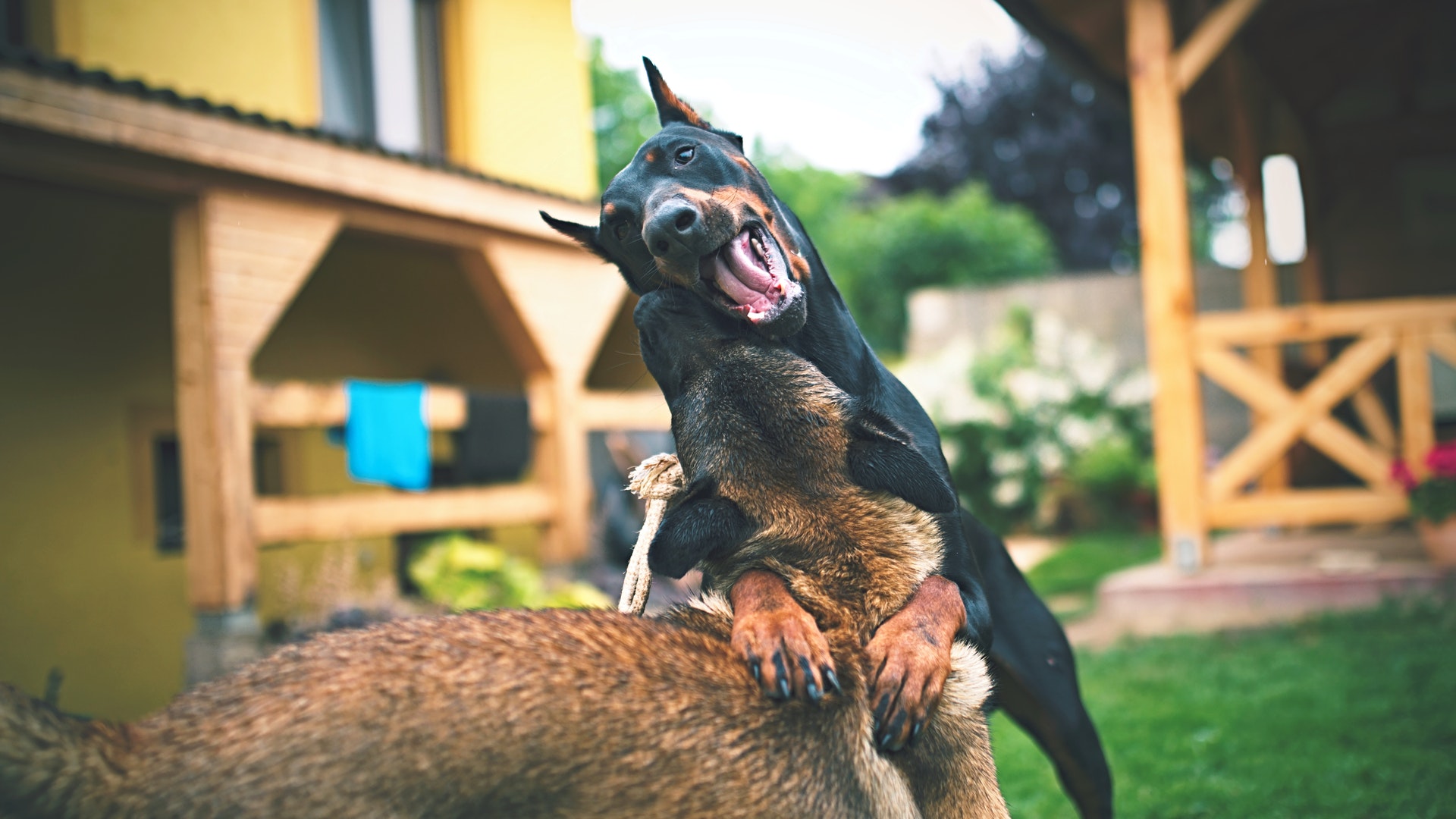
How to Stop Your Dog From Going Crazy Around Other Dogs
Some of the tricks you can use to calm your dog’s craziness will work regardless of its cause.
Teaching them to control their emotions is going to do the world of good, no matter what’s motivating their behavior.
Remember the Dog Calming Code I introduced you to earlier? This is where it really shows its value.
Other fixes are more specific. And depending on what’s driving your dog’s behavior. The following solution can help put an end to the craziness once and for all.
Desensitize a Leash-Reactive Dog
If your dog’s craziness is limited to when they’re walking on a leash. Some simple counter conditioning and desensitization techniques can help.
In the time between them noticing another dog and reacting, praise and reward them with some high-value treats.
The treats should only be given before they react, which will usually be when the other dog is still at a distance (at least at first – over time, you can work on reducing their comfort threshold).
The idea is to teach them that good things happen around other dogs, replacing any negative associations with positive ones.
Stop Dog-on-Dog Aggression
If you want to stop dog-on-dog aggression, you’ll need to work on your own reactions first.
If you’ve become used to your dog reacting negatively around other dogs. It’s only natural that you’ll become tense and anxious whenever the situation arises.
Unfortunately, your dog is probably picking up on those emotions, which in turn can exaggerate their own feelings of anxiety or aggression.
Hard though it is, try to keep calm and relaxed.
If you come across another dog on a walk, avoid adding tension to the leash or jerking them away.
Distract their attention from the other dog with some treats. You could even try running through some basic obedience commands.
The more distracted your dog is, the less likely they are to react in a negative way.
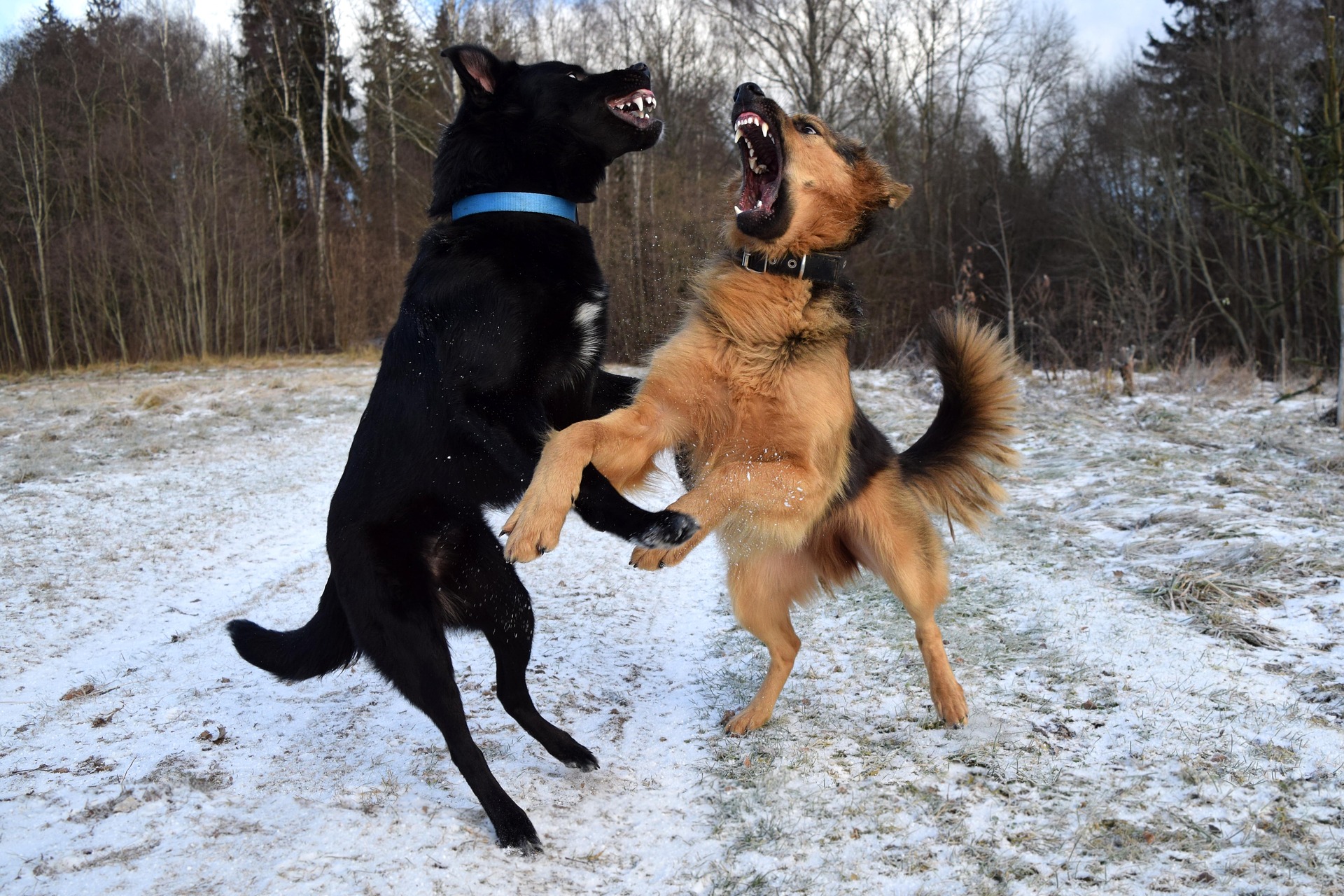
Calm a Fearful Dog
Don’t underestimate your own importance. As the pack leader, your emotions will have a direct bearing on how your dog reacts.
Even if your instinct is telling you to run away from an approaching dog before your own reacts, keep calm and upbeat.
Showing signs of tension or anxiety will only worsen those same emotions in your dog.
Resist the urge to drag them if they pull away or refuse to budge. Instead, wait until they start to move toward you and reward them when they do.
A fearful dog is also an ideal candidate for the Dog Calming Code I mentioned previously.
Remember that as with most things, practice and consistency are key – the more consistent you at introducing the techniques from the program into your routine, the better the results.
Chip Away at Anxieties
If your dog’s never been properly socialized, it’s easy for them to go on the offensive when they come across an unfamiliar dog.
Forcing them into uncomfortable situations with overly assertive or enthusiastic dogs rarely helps.
Engineering meet and greets with friendly, relaxed dogs, on the other hand, can help chip away at their old anxieties.
The more positive experiences your dog has with other dogs, the more resilient and confident they’ll become.
Reduce Hyperactivity
Pent up energy combined with boredom is a recipe for disaster. Dogs that aren’t mentally or physically stimulated can indulge in all kinds of craziness, from general unruliness to roughhousing, barking, and whining.
If your dog’s craziness around other dogs is rooted in hyperactivity. You need to find a new outlet for their energy.
Step one? …Increase their exercise. A tired dog is a happy dog.
Find new ways to introduce healthy activity into their life.
If you like jogging, take them with you.
Like hiking?
Then make it your mission to seek out dog-friendly trails you can take your dog to.
If you’re not the active sort yourself, add some games like catch, tug of war, and frisbee into your routine. In games like this, your dog will be the one to do all the running.
While we’re on the subject of exercise, don’t overlook the importance of giving their brains a workout.
Puzzles and interactive toys are a great way to keep your pooch occupied and reduce any tendencies towards hyperactivity.
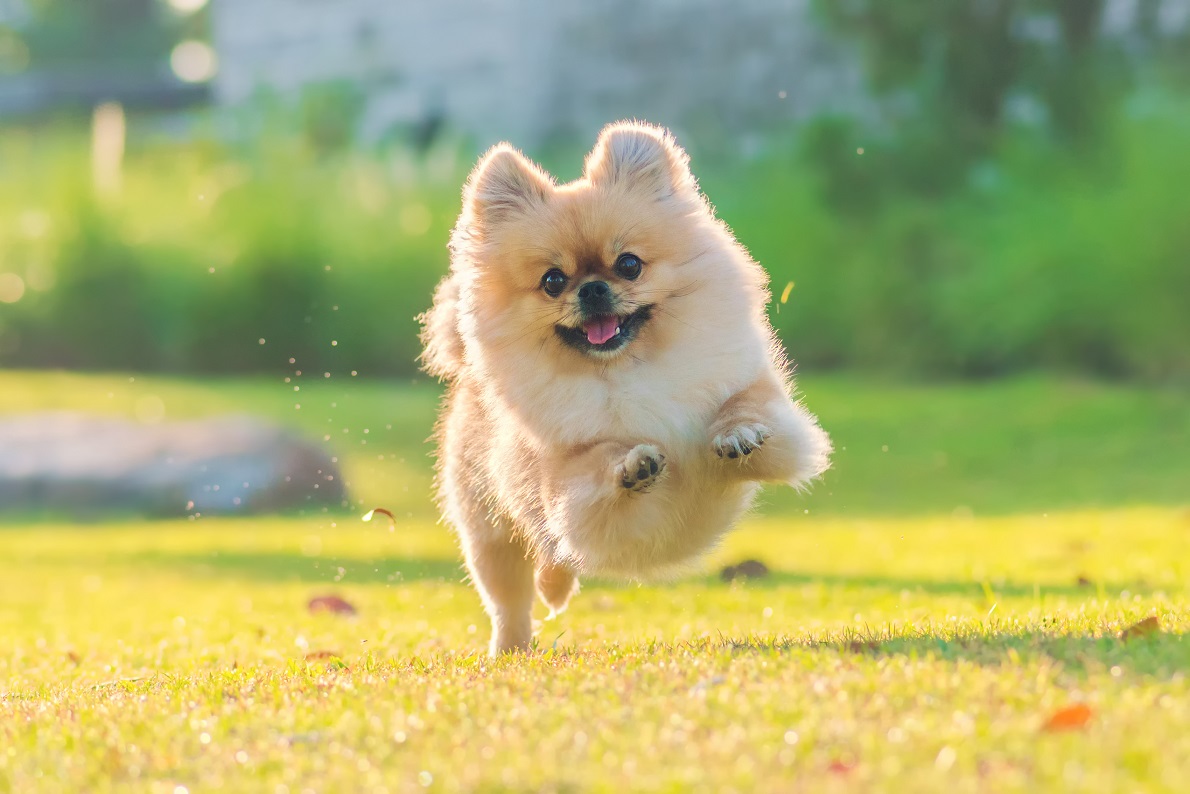
Dial Down the Excitement
If you’ve got a friend with a dog that’s so laid back, they’re practically horizontal, recruit their services.
Set them up on one corner of the street. Stand at a distance that’s comfortable for your dog. Approach slowly, working with your own dog to keep their focus firmly on you (clue: treats help).
If they display any signs of over-excitement as you approach, backtrack before repeating the process.
At first, keep the sessions short and sweet. Keep practicing until they can walk calmly past your friend’s dog without turning into a lather of excitement.
Before each session, give them a chance to burn off some energy with some exercise. Now’s also a good time to run through the Dog Calming Code to get them into a good, ready-to-train state.
Create Distractions
If the sight of every new pooch turns your dog into a crazy nut, learn how to keep their focus firmly on you.
Each time you head out for a walk, mix things up.
Circle back on yourself, change your pace, rotate, create obstacle courses from trees and benches…. basically, be unpredictable.
If your dog’s focused on working out what you’re going to do next, they’ll be too busy to even notice other dogs, let alone react to them.
Final Thoughts
Dealing with a dog that goes crazy around other dogs isn’t easy. But with the right techniques and the proper methods, it’s a problem that can be overcome.
Regardless of what’s motivating your dog’s behavior and regardless of what solution you use, remember to keep calm. Letting your dog sense your tension will only make the problem worse.
Keep patient, keep calm, and keep carrying on… you’ll get there sooner than you think.
